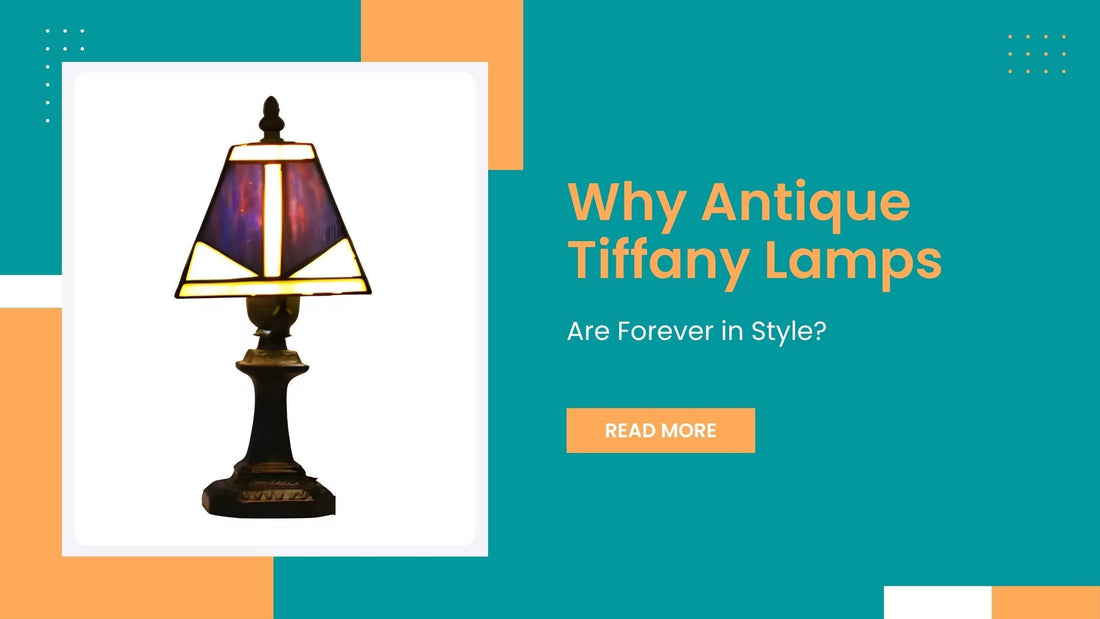
Why Antique Tiffany Lamps Are Forever in Style?
Share
Introduction
When it comes to timeless design and artistic brilliance, few creations rival the beauty of antique Tiffany lamps. Crafted in the late 19th and early 20th centuries by Louis Comfort Tiffany and his studio, these stained-glass masterpieces are not just functional lighting — they are enduring symbols of elegance, craftsmanship, and American decorative art.
In a world increasingly dominated by mass production, the delicate handiwork and natural inspiration behind each Tiffany lamp make them more desirable than ever. From record-breaking auction sales to celebrity homes and museum showcases, their glowing legacy continues to captivate collectors and design lovers alike.
In this blog, we’ll uncover why antique Tiffany lamps remain so valuable, how to distinguish the real from the replica, and what makes each piece a story in light and glass.
A Rising Market: The Growing Demand for Antique Tiffany Lamps
Over the past two decades, the market for antique Tiffany lamps has grown steadily—and in many cases, dramatically. While they’ve always been coveted by collectors, recent years have seen a renewed interest from design enthusiasts, investors, and celebrities alike.

Why the surge in popularity?
- Scarcity: Tiffany Studios closed in 1933, making original lamps rare and irreplaceable.
- Craftsmanship: Each lamp is handcrafted—no two are identical.
- Investment value: Some lamps appreciate more reliably than stocks or real estate.
- Cultural recognition: Featured in films, museums, and celebrity homes.
In auctions, high-end Tiffany lamps consistently command six- to seven-figure prices. Even smaller or lesser-known designs hold strong value, especially when provenance is documented.
Iconic Patterns: The Stories Behind the Glass
Each antique Tiffany lamp tells a story—not just through its colors and patterns, but also in its inspiration. Louis Comfort Tiffany was deeply influenced by nature, and his studio created hundreds of patterns reflecting flora, fauna, and organic forms.
Here are a few of the most iconic:
The Dragonfly
One of the most beloved designs, the Dragonfly pattern features vibrant glass wings, jewel-like eyes, and intricate soldering. Often produced with iridescent or opalescent glass, the pattern represents transformation and power.
- First introduced: Around 1900
- Fun fact: Designed by Clara Driscoll, one of Tiffany Studios’ most celebrated female artisans.
The Peacock
This luxurious pattern showcases sweeping tail feathers in shimmering blues and greens, mimicking the elegance of a peacock in display.
- Symbolism: Pride, immortality, beauty
- Design complexity: Requires hundreds of small curved glass pieces
The Wisteria
A cascading masterpiece of soft blues, purples, and greens, the Wisteria lamp has a famously irregular edge to mimic real floral draping.
- Made with: Over 2,000 individual glass pieces
- Base: Often styled like a tree trunk
These intricate designs are a key reason antique Tiffany lamps are treasured—not only as lighting but as fine art.
Famous Collectors and Their Lamp Stories

The beauty of Tiffany lamps has attracted admirers from all walks of life—actors, royalty, musicians, and moguls. These notable collectors prove that the fascination with antique Tiffany lamps transcends time and trend.
Barbra Streisand
The legendary singer and actress is known for her exceptional interior taste and antique collection. Her Malibu home once showcased authentic Tiffany fixtures, including rare floral table lamps.
The New-York Historical Society
Home to one of the world’s largest collections of original Tiffany lamps, the museum preserves over 100 pieces, showcasing the evolution of Tiffany’s work from delicate florals to bold geometrics.
Oprah Winfrey
Oprah has reportedly purchased vintage and antique Tiffany lamps as gifts for friends and as centerpiece décor in her own residences.
These stories only add to the mystique—each lamp passed down or displayed tells not just a design story, but a personal one.
Tips to Spot Fake vs. Real Antique Tiffany Lamps
Because of their high value, antique Tiffany lamps are frequently replicated or faked. For collectors and enthusiasts, knowing what to look for is crucial. If you're comparing with table tiffany style lamps, keep in mind the following distinctions:
1. The Maker's Mark
Genuine bases are often stamped:
- “Tiffany Studios New York”
- Accompanied by a serial or model number
- Found near the base or under the lamp
Beware of sloppy or overly stylized stamps—real ones are clear, neat, and consistent.
2. Real Glass or Fake Plastic?
Original Tiffany shades use Favrile glass—colored through and through, not painted. Look for:
- Color variation when unlit
- A cool, solid feel to the touch
- Bubbles, swirls, or tiny imperfections—proof of handwork
Tap lightly—real glass rings, while plastic gives a dull thud.
3. The Patina Test
Tiffany used solid bronze bases, which develop a natural patina over time. If the base looks:
- Too shiny
- Painted gold or silver
- Lightweight and hollow
…it’s likely a reproduction.
4. Seek Provenance
The most trustworthy antique Tiffany lamps come with:
- Documentation
- Auction history
- Appraisal certificates
Buying from reputable dealers, galleries, or auction houses is always advised for serious collectors.
Conclusion: Art That Lights the Way
The appeal of antique Tiffany lamps isn’t just about age or rarity—it’s about a legacy. These lamps blend beauty, craftsmanship, and timeless design in a way few objects can. They glow with history, literally and figuratively.
Whether you admire them from afar or dream of owning one someday, Tiffany lamps remind us that true artistry never fades—it only shines brighter with time.
In a modern world, they remain eternal icons. And that’s why antique Tiffany lamps will forever be in style.
FAQ: Antique Tiffany Lamps
1: How much does an original antique Tiffany lamp cost?
Prices vary widely. Simpler designs may sell for $10,000–$50,000, while rare masterpieces like the Wisteria or Peacock lamps can reach $500,000+.
2: Are all stained-glass lamps considered Tiffany lamps?
No. Only lamps made by Tiffany Studios (1890s–1930s) are considered authentic. “Tiffany-style” lamps are inspired by the originals but are not antiques.
3: Where can I buy an antique Tiffany lamp?
- Auction houses (e.g., Sotheby’s, Christie’s)
- Trusted antique dealers
-
Museums or estate sales
Always request authentication.
4: How do I care for an antique Tiffany lamp?
- Dust gently with a soft cloth
- Avoid direct sunlight (can fade glass over decades)
- Use low-heat LED bulbs
- Never use ammonia-based cleaners
5: Can I insure my Tiffany lamp?
Yes—and you should. Contact a fine art insurance provider and get a professional appraisal to determine current market value.
Frequently Linked Pages
1. Table Tiffany Style Lamps - The Ultimate Guide to Table Tiffany Style Lamps: Elegance and Craftsmanship
2. Tiffany Table Lamp - The Ultimate Guide to Tiffany Table Lamp: History, Styles, and Buying Tips
